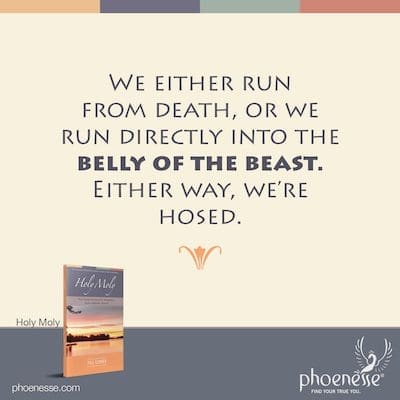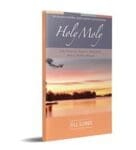The big enchilada we need to deal with—really get our arms around—is death. Even if our lives were no longer filled with our many little mini-dramas, in the end, physical death remains. And it’s a mystery. An unknown. No matter how much we think we know, it’s all conjecture. It’s our fear of death that creates the world of duality, this life and death reality we live in. The one that says No to our longing for total fulfillment. Yep, death is a problem for us. So we need to deal with it directly to break its grip on us.
What we sometimes do is take the calming words of a spiritual teacher—one who has gone before us and seems to know the way—and try to apply their ready-made answers to our lives. Why doesn’t this work? Because if these answers aren’t yet true for us—personally—they’re going to fail. We each have to arrive at them using the strength and courage that can come only by fearlessly facing our own issues.
Trying to go the avoidant route happens due to our fears and weakness. People who are religious will sometimes cling to their faith because of this type of fear. We won’t even let ourselves imagine what it could be like to experience pleasure supreme on all levels of our being. In fact, we may even think of “divine bliss” as something that would be dull, sterile and uninteresting. Believe it or not, all of this is wrapped up in our confusions and fundamental fear of death.
We may think that what we really long for is the state of serenity we were in, back in our mother’s womb. That things have really gone downhill ever since. But it actually goes back further than that. We each have imbedded in us a vague memory of life in another state of consciousness, when we knew nothing but bliss without anything opposing it.
We can recapture that, by degrees, while we are here. But as we work through our issues that block us from our inner happy place, we are bound to encounter the world of duality. To go through this level, we come face to face with our fears, with everything “bad” that opposes the “good.” And that’s how we come right up against that big mother of them all—death.

We cope with death in one of two ways. We either run from it, or we run directly into the belly of the beast. Either way, we’re in trouble. The struggle rages on. It’s a totally different deal to accept death in a healthy way, from a place of strength.
Open your arms wide and bring every kind of death into the circle. This includes everything that opposes our drive for pleasure. Loss, change, the unknown—it can all be terrifying. Every single one of us has many opportunities to die many little deaths every day.
This willingness to die to life’s little disasters—to any unpleasantness that is part and parcel of life on this planet—determines our capacity to fully live and experience pleasure. The healthier we are about death and the more open we are to it, the more open we are for life. The more life force that is able to flow through us, the healthier we’ll be. And so the more we’ll be able to enjoy our pleasure drive.
So step one: take a look at just how much you struggle against death—this honestly may be hidden from view, even from you—along with your constant longing for pleasure supreme. We’ve all picked our poison—run away or rush into it. What’s your personal favorite?
Sometimes we play mind games with ourselves that sound like this. “Death, or loss, is unavoidable anyway, so I might as well just get it over with.” And sometime we’re not just playing games here. Suicide is an extreme example of what happens when we get super-sideways on this.
So we find ourselves torn between two unsatisfactory solutions toward death, both of which end up bringing us nearer to what we want to avoid. And they cause us to give up what we hope to gain. Ay caramba. The real answer lies not in just acceptance, but the right kind of acceptance.
When it mixes with fear and negativity, it takes us down a road to self-destruction. When it’s strong and has a healthy respect for the inevitable, it helps us come to terms with it. We need to face our struggles squarely, pull back our shoulders, and stop cringing away—both from death and from life.

We are kidding ourselves if we believe we can simply rise above the duality of pleasure and pain. While this may be true in the ultimate sense, it’s not true that we can flee unpleasantness this way. The only way to transcend this reality is by being fully in it—life and death—accepting both in their undisguised nakedness. Then we can find out that there is no death and no duality. But only then.
When we don’t get our way, we must die to that. That’s how the dice roll in the real game of life. Jesus said, “Become ye as little children.” This has meaning on many levels. One is that we need to be willing to experience everything—very acutely. Rather than deadening our feelings, we are better off going through life feeling all its hills and valleys. Detachment before we have felt the burden and the burn creates a false serenity. And when we cut off any aspect of living, including the hard parts, we’ll have to circle back around and have a run at them again later. There are no shortcuts to the mountaintop.
It is true that those who struggle regularly with ups and downs are deeply involved with the illusion of opposites. They’re spinning in the land of duality. But they’re in it, not trying to rise above it, and that is honest and in the end, growth producing.
We need to muster all the courage and honesty we can for this most important journey. If we do this and face both our suffering and our joy, we are sure to grow. To do otherwise reveals what is actually, beneath it all, a fear of happiness and fulfillment. Crazy, that.
When happiness seems far away and unattainable, it seems safe to long for it. But when it starts to appear more near, we start to cringe—exactly the same as we might cringe away from suffering. And there it is again, that all-is-one idea. These are really connected. If we’re afraid of pain and suffering, we are also, in some strange way, really also afraid of pleasure and happiness. Accept one, you accept the other. Rise and go through one, and yep, you get the other. What’s more, that which formerly made you suffer can stop hurting the instant you recognize the lesson it can teach you. How about that for a nice, gentle wake-up call.
There is a lot be said for the attitude we bring to all of this. If we meet our suffering in a spirit of whole-heartedness, willing to learn from it and keeping our reasoning faculties intact, we will learn and grow. This is true, even if emotionally we may have to blunder our way through darkness, rebellion, cowardice and self-pity. But if we allow our suffering to deaden us, if we suppress our feelings and distract ourselves, the whole thing is just going to take a whole lot longer to plow through. If we can help it, we should try not to waste our time this way.
Also, don’t get confused into thinking, as some religions have, that we should deliberately choose suffering and reject happiness, in some misguided notion that pleasure and joy are not on God’s agenda for us. God’s will for us is good, even if he has to lead us through our dark spots to help us get to it. Those are our dark spots, not God’s.
Here’s another weird thing we do with this. We start to get a clue that these imperfections are really part of us. Then when suffering comes along, we can get impatient to uncover the hidden cause. Until we do, we can get paranoid that more suffering is coming our way. And we end up sabotaging our own attempts to get to the root cause.
In our haste, we inadvertently slow down the process of healing and growing. It would have been better to just believe that God causes our suffering and that we have to accept this without understanding why. We would actually fare better because we wouldn’t get in our own way. The pity of such a perspective is that we don’t ferret out the real cause. And eventually this work must be done. But such a person will tend to be more relaxed and open. On the other hand, this way of thinking easily leads to the conclusion that God is cruel and sadistic.
So we need to search with the right balance of activity and passivity. Whenever we’re disturbed, we need to go on an expedition to uncover what we really want, and what we really fear—deep below the surface of things. And don’t start by trying to tackle big, existential things. All this happens in our seemingly insignificant daily reactions. It’s there in even the slightest little disharmony.

At the end of the day, all the little issues in our lives ultimately lead to the question of being loved versus not being loved—and therefore to life versus death. When we run from what we really want into deliberately choosing what we don’t, we create a deadening in our souls that is downright unhealthy. It’s also dishonest. Because then we’re not acknowledging to ourselves that we really want love and life, and that we’re scared to death we’re not going to get it.
In this way, we deny ourselves what we could have, although it may not be to the degree we wish it. We may not get exclusive, unlimited, guaranteed-for-certain love, but it’s also not true that nonfulfillment of this wish is that unbearable. So we forfeit what we could have by rejecting it altogether. In this either-or approach, we make things worse.
We need to become aware of our very real fear of death—in all its many varieties, from physical death to minor negative occurrences—as a way to wake up and really live.
So just how do we go about this business of dying? Jesus Christ showed us the way when he was dying on the cross, crying out, “My God, my God, why have you forsaken me?” We have to be with whatever is true for us in each moment, and die to that. All the great sages and truth seekers of all times also have known about this. So we can find it in many philosophies, myths and religions.
Jesus’ followers could not have known what an important lesson this was that they were witnessing. Even though they could not consciously understand how it was possible that the Master experienced such doubt in his hour of death, inwardly they felt more strengthened than ever. Because truth goes directly to the heart and soul, even if at times it bypasses the brain.
When we are able to let our intuition function, and not let intellectual explanations obscure what the heart and soul perceive, that’s when we “become as little children”. There is a purity and innocence in us when we are willing to experience life so intensely.
This kind of purity is not the kind of insipid “purity” that rejects the body. The body and the spirit are integrally and intimately connected. They form one whole. That’s part of the reason why God appeared in the form of a human being, as Jesus. To show that the body is not to be rejected or denied. So this resurrection in the body—in life, really—allows the life force to flow on all levels of our being, including the physical.
The deeper message is that if you meet both life and death, you cannot die. And this is what occurred when Jesus appeared to his disciples after his death. The phenomenon that occurred was a materialization, a condensation, if you will, of spirit matter. Which is essentially what all physical life is. The real story was not that Jesus came back to life, it was that all of us have this ability to transcend the duality of life and death, and in this way, truly live. When we choose Jesus, we are choosing this way.
Return to Holy Moly Contents
Read Original Pathwork® Lectures:
81 Conflicts in the World of Duality
82 The Conquest of Duality Symbolized in the Life and Death of Jesus



